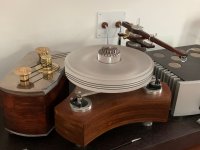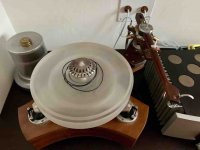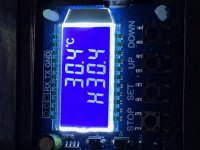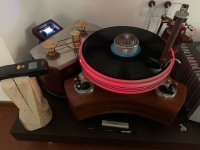Ceramic additive is usually used in automobile engines to cut down wear on start up but most record deck bearings always run in a bath of oil --mine does .
It applies a coating to the bearing surface and there science departs from subjectivism , not always liked ( some say it accentuates the higher frequencies) but I leave that to others to decide, although you can buy ceramic bearings for some turntables or just the ball that runs on the thrust-pad.
I don't want to get into a science v subjectivism argument but there are pretty strong views on the subject ---not all peaceful.
It applies a coating to the bearing surface and there science departs from subjectivism , not always liked ( some say it accentuates the higher frequencies) but I leave that to others to decide, although you can buy ceramic bearings for some turntables or just the ball that runs on the thrust-pad.
I don't want to get into a science v subjectivism argument but there are pretty strong views on the subject ---not all peaceful.
At 33 RPM, no need.
Car engines can rev up past 7000 RPM, and cold start in freezing conditions is much more arduous for bearings than a single bearing running at max 45 RPM.
The user experience of ceramic coated bearings in cars has not been very good, and the technique has been used to coat the wear surfaces of hip joints to reduce wear.
However, the makers recommend these mostly for younger patients who are still physically active, for a retired person a metal joint with plastic wear insert is normally used.
The main issue has been of poor adhesion of the ceramic coating to the metal backing in the joint. Sometimes the joint needs to be replaced.
And that is not cheap, and it is a little tricky as well to replace a hip joint that has been bonded to bone
Therefore, a good concept in theory, but still not practical for main stream use.
Try Teflon grease, molybdenum sulfide grease, or copper powder containing anti seize compound as alternates to the current lube in use. You might get these in oils too if your bearing runs in oil.
Car engines can rev up past 7000 RPM, and cold start in freezing conditions is much more arduous for bearings than a single bearing running at max 45 RPM.
The user experience of ceramic coated bearings in cars has not been very good, and the technique has been used to coat the wear surfaces of hip joints to reduce wear.
However, the makers recommend these mostly for younger patients who are still physically active, for a retired person a metal joint with plastic wear insert is normally used.
The main issue has been of poor adhesion of the ceramic coating to the metal backing in the joint. Sometimes the joint needs to be replaced.
And that is not cheap, and it is a little tricky as well to replace a hip joint that has been bonded to bone
Therefore, a good concept in theory, but still not practical for main stream use.
Try Teflon grease, molybdenum sulfide grease, or copper powder containing anti seize compound as alternates to the current lube in use. You might get these in oils too if your bearing runs in oil.
Last edited:
Ceramic coated knee joints are also available, but again recommended for young patients.
There have been class action suits on joint makers after they were found to be knowingly selling poor quality joints which infected the patients, some died.
But that is off topic really.
If you need to improve the sound quality or bearing performance, someone in this forum. wiseoldtech or OldDIY - recommended a silicon based lubricant, which I said was not suitable in hot conditions like those in India, as those break down, as an alternate I now use front axle grease, which is very stable and durable compared to regular grease.
Bearing these in mind, you are welcome to try whatever you feel is suitable.
There have been class action suits on joint makers after they were found to be knowingly selling poor quality joints which infected the patients, some died.
But that is off topic really.
If you need to improve the sound quality or bearing performance, someone in this forum. wiseoldtech or OldDIY - recommended a silicon based lubricant, which I said was not suitable in hot conditions like those in India, as those break down, as an alternate I now use front axle grease, which is very stable and durable compared to regular grease.
Bearing these in mind, you are welcome to try whatever you feel is suitable.
Axle grease ?------ when the correct oil for turntables is very light and while okay in a capped or sealed bearing in an automobile which warms to a THICK liquid would certainly affect the rotational performance of a precise running quality turntable which does not obtain a vehicles rotational speed to cause the grease to heat up .
Thats apart from the pressure applied from the walls of the bearing to the inserted platter spindle increasing pressure causing belt slippage .
Thats apart from the pressure applied from the walls of the bearing to the inserted platter spindle increasing pressure causing belt slippage .
Hi,
Actually since my main platter bearing have the sphere worn a bit after 15 years of use I will replace it with a 5 mm ceramic sphere. Therefore I think this shall be ok for the complete oil bath bearing and by the way I do not use sintered bushes but bronze bushes that makes difference in selecting the lubricant.
I plan instead to try to use the ceramic additive for my drive unit with fly wheel as there is difference in RPM when I just start it ( cold ) and after 40 minutes when reach the desired speed. Also for this unit I have a oil bath and bronze bushes, but perhaps I made a mistake using a 18mm bearing, I suppose a 13mm would have had less unevenness in cold and hot running. It s a fact that allowance are not too loser , pretty precise indeed and takes log long time to lower it when in let the oil. Therefore grease I think out of question.
Tks n rgds
Adelmo
Actually since my main platter bearing have the sphere worn a bit after 15 years of use I will replace it with a 5 mm ceramic sphere. Therefore I think this shall be ok for the complete oil bath bearing and by the way I do not use sintered bushes but bronze bushes that makes difference in selecting the lubricant.
I plan instead to try to use the ceramic additive for my drive unit with fly wheel as there is difference in RPM when I just start it ( cold ) and after 40 minutes when reach the desired speed. Also for this unit I have a oil bath and bronze bushes, but perhaps I made a mistake using a 18mm bearing, I suppose a 13mm would have had less unevenness in cold and hot running. It s a fact that allowance are not too loser , pretty precise indeed and takes log long time to lower it when in let the oil. Therefore grease I think out of question.
Tks n rgds
Adelmo
Mine is heavy too it helps with speed stability instead of a mass of electronics and a lightweight platter where all sorts of stability issues appear on every audio website including this one due to electronic --hard to locate faults .
One big problem with modern heavy decks is the price , mine at the time ( 80,s ) cost £500 now for the same level of engineering its several £1000 .
And the same as you when putting the platter back on in the oil bath it take a while for the spindle to descend , I made sure I bought it from a UK engineering company and even spoke to the design engineer --quality engineering .
One big problem with modern heavy decks is the price , mine at the time ( 80,s ) cost £500 now for the same level of engineering its several £1000 .
And the same as you when putting the platter back on in the oil bath it take a while for the spindle to descend , I made sure I bought it from a UK engineering company and even spoke to the design engineer --quality engineering .
Hi,
My acrylic platter have diameter 320mm and 47mm thickness, weight around 4 Kg.
The brass fly wheel have a diameter of 90mm and weight 4 Kg, is driven by two motors.
The platter bearing have a diameter of 11mm, is in oil bath, uses bronze bushes. I only need to change the sphere that have some wear after 15 years with a new ceramic one only.
With the single motor drive the platter reach the 33.33 Rpm immediately and is very steady even without the speed regulator. The 5.5 inch floppy motor runs accurately at 360 Rpm and the electronic that control it is pretty good.
The problem i have is with the two motors plus fly wheel drive that need time to reach the perfect speed 33.33 Rpm. Most probably is due the friction of the bearing that have a bigger diameter 19mm, I suppose a 13mm was more suitable but too late now. I do not lijke to reduce the fly wheel weight, but rather try to reduce the friction between cold and warm rotation using the ceramic additive. I have bronze bushes so I may try.
Therefore was my question.
Attache some pictures.
Adelmo
My acrylic platter have diameter 320mm and 47mm thickness, weight around 4 Kg.
The brass fly wheel have a diameter of 90mm and weight 4 Kg, is driven by two motors.
The platter bearing have a diameter of 11mm, is in oil bath, uses bronze bushes. I only need to change the sphere that have some wear after 15 years with a new ceramic one only.
With the single motor drive the platter reach the 33.33 Rpm immediately and is very steady even without the speed regulator. The 5.5 inch floppy motor runs accurately at 360 Rpm and the electronic that control it is pretty good.
The problem i have is with the two motors plus fly wheel drive that need time to reach the perfect speed 33.33 Rpm. Most probably is due the friction of the bearing that have a bigger diameter 19mm, I suppose a 13mm was more suitable but too late now. I do not lijke to reduce the fly wheel weight, but rather try to reduce the friction between cold and warm rotation using the ceramic additive. I have bronze bushes so I may try.
Therefore was my question.
Attache some pictures.
Adelmo
Attachments
No worries there I have a thin round belt and it looks "stupid " in relation to the weight it has to overcome and yes it takes a few seconds like yours to reach the desired speed .
But that's intentional as very little ( if any ) transmission of noise is transmitted by the belt , I have just turned it on and its takes about (approx ) 3 seconds to reach the correct speed but --no worries from me I would rather have that than a thick heavy belt transmitting noise into the platter.
Your acrylic platter "rings a bell " with me several UK designs of the 80,s /90,s used the same type of material as it helped with resonances.
But that's intentional as very little ( if any ) transmission of noise is transmitted by the belt , I have just turned it on and its takes about (approx ) 3 seconds to reach the correct speed but --no worries from me I would rather have that than a thick heavy belt transmitting noise into the platter.
Your acrylic platter "rings a bell " with me several UK designs of the 80,s /90,s used the same type of material as it helped with resonances.
When I used a Mylar belt I used splicing tape. Cut the Mylar on a diagonal and tape over the seam.
http://www.amazon.com/TME-Splicing-Archival-Recording-AC1S94B1C/dp/B00NLYEMBA
The tape is available in different widths.
Scott
http://www.amazon.com/TME-Splicing-Archival-Recording-AC1S94B1C/dp/B00NLYEMBA
The tape is available in different widths.
Scott
No worries there I have a thin round belt and it looks "stupid " in relation to the weight it has to overcome and yes it takes a few seconds like yours to reach the desired speed .
But that's intentional as very little ( if any ) transmission of noise is transmitted by the belt , I have just turned it on and its takes about (approx ) 3 seconds to reach the correct speed but --no worries from me I would rather have that than a thick heavy belt transmitting noise into the platter.
Your acrylic platter "rings a bell " with me several UK designs of the 80,s /90,s used the same type of material as it helped with resonances.
Hi,
I have used the Cera Tec additive in the Fly Wheel bearing and also the Platter bearing. The improvements were too little to say that the Cera Tec improve my TT bearing spinning, however the fly wheel increased the speed of 1% using this additive.
I solved the time delay in reaching the 33.33RPM implementing the fly wheel s bearing heater and a temp controller.
Tks and regs all.
Adelmo
Hi,
At the present I use my TT with Fly wheel bearing heater and temp controller. 33.33 RPM reach in about 1 minute since I turn it on that is acceptable for me.
May be not a perfect engineering but seems is working well and sound pretty good.
Rgds
Adelmo
At the present I use my TT with Fly wheel bearing heater and temp controller. 33.33 RPM reach in about 1 minute since I turn it on that is acceptable for me.
May be not a perfect engineering but seems is working well and sound pretty good.
Rgds
Adelmo
Attachments
Nice set up 12Russel3456 but I did not realize that it took 60 seconds to reach the correct speed .
I know you are happy with the sound and its probably my engineering brain cells in overdrive but this is a typical engineering problem of mass-v- inertia -v- energy required to overcome it.
If you reduce the mass by removing the LP clamp does it make any difference or is the clamp a light alloy ?
If not then is the motor applying the correct =Foot/Pound of energy as ( I take it ) there is no belt slippage ?
I have a heavy old Dais ( early Nottingham Analog ) with a very flimsy round belt but even there it only takes a few seconds to reach the correct speed but the motor is expensive / powerful ( but quiet ) .
I know you are happy with the sound and its probably my engineering brain cells in overdrive but this is a typical engineering problem of mass-v- inertia -v- energy required to overcome it.
If you reduce the mass by removing the LP clamp does it make any difference or is the clamp a light alloy ?
If not then is the motor applying the correct =Foot/Pound of energy as ( I take it ) there is no belt slippage ?
I have a heavy old Dais ( early Nottingham Analog ) with a very flimsy round belt but even there it only takes a few seconds to reach the correct speed but the motor is expensive / powerful ( but quiet ) .
Hi Duncan,
About 1 minute is the time needed by the fly wheel bearing heater to reach the normal spinning temperature of the fly wheel. In fact at the present the bearing have a temp of about 21 to 22 Celsius while the normal spinning bearing temp would be around 30.5 Celsius. The fly wheel have a diameter of 90mm weight about 4 Kg, has some inertia but it is wanted to better drive the platter. The bearing has a pretty precise allowance as I prefer in these bearing. I could use thicker belts to drive the fly wheel, but I think the belt with a section diam 2.4mm is the best solution and compromise. Not too thick not. too thin. The platter is driven with 3 belts 1.6mm section diam. I also think this is a good compromise.
If I spin the TT without he fly wheel and with the single motor pod I reach the 33.33 RPM immediately.
My allowance of the fly wheel bearing is pretty precise therefore I need a constant temperature of the bearing. Someone said that such temp variation will not make any difference, but according to my check it makes a difference indeed. I checked the RPM with an outer laser tachometer and the bearing temperature, it was very inspiring. I wonder if anyone have ever checked it.
Tks for the support.
Rgds
Adelmo
About 1 minute is the time needed by the fly wheel bearing heater to reach the normal spinning temperature of the fly wheel. In fact at the present the bearing have a temp of about 21 to 22 Celsius while the normal spinning bearing temp would be around 30.5 Celsius. The fly wheel have a diameter of 90mm weight about 4 Kg, has some inertia but it is wanted to better drive the platter. The bearing has a pretty precise allowance as I prefer in these bearing. I could use thicker belts to drive the fly wheel, but I think the belt with a section diam 2.4mm is the best solution and compromise. Not too thick not. too thin. The platter is driven with 3 belts 1.6mm section diam. I also think this is a good compromise.
If I spin the TT without he fly wheel and with the single motor pod I reach the 33.33 RPM immediately.
My allowance of the fly wheel bearing is pretty precise therefore I need a constant temperature of the bearing. Someone said that such temp variation will not make any difference, but according to my check it makes a difference indeed. I checked the RPM with an outer laser tachometer and the bearing temperature, it was very inspiring. I wonder if anyone have ever checked it.
Tks for the support.
Rgds
Adelmo
- Home
- Source & Line
- Analogue Source
- Using Ceramic or similar in the platter bearing



